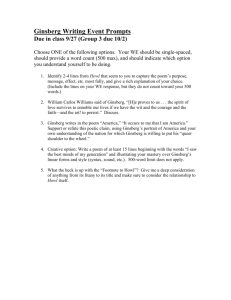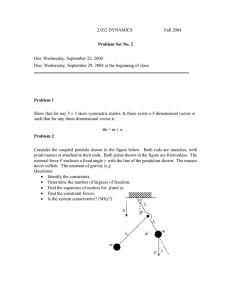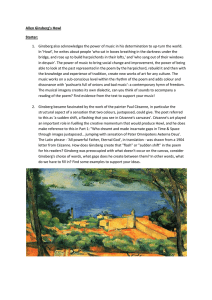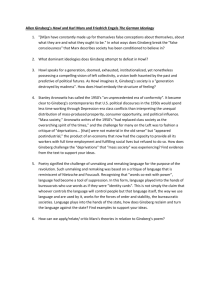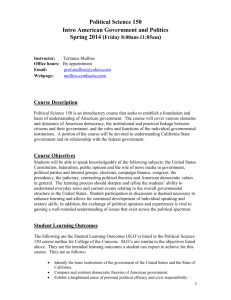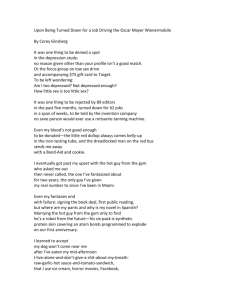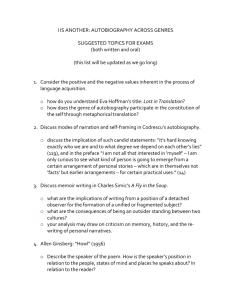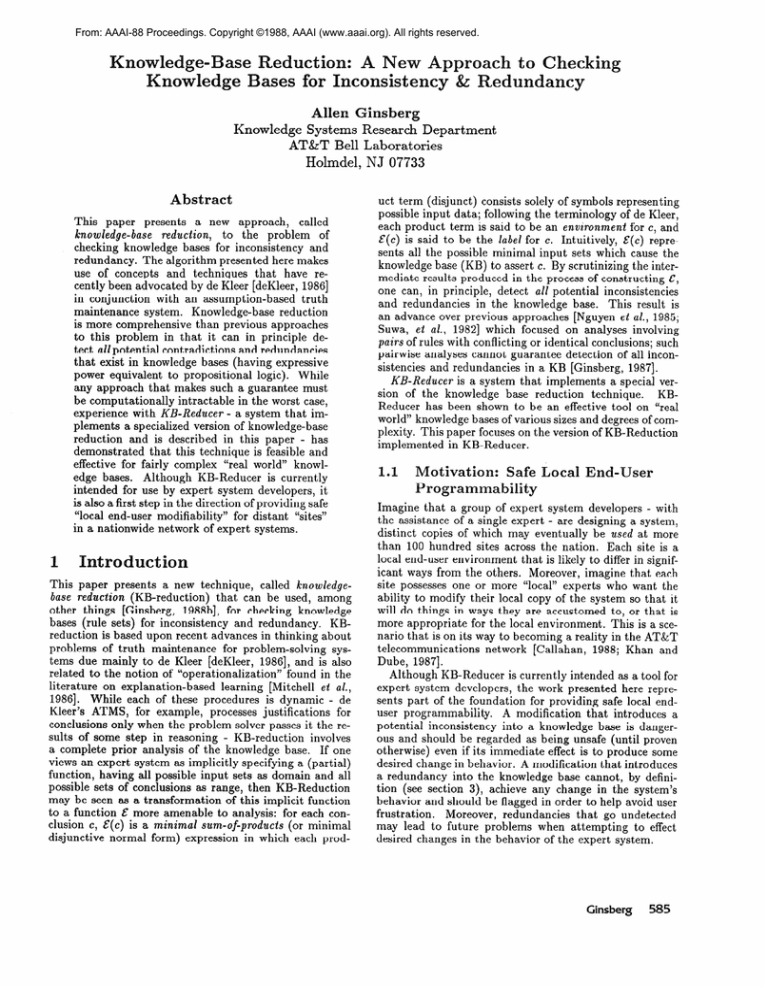
From: AAAI-88 Proceedings. Copyright ©1988, AAAI (www.aaai.org). All rights reserved.
KnowledgeKnowledge
A New A
eduction:
Bases for Inconsistency
oath to Checking
Redundancy
Allen Ginsberg
Knowledge Systems Research Department
AT&T Bell Laboratories
Holmdel, NJ 07733
Abstract
This
paper
a new approach, called
to the problem of
checking knowledge bases for inconsistency and
redundancy. The algorithm presented here makes
use of concepts and techniques that have recently been advocated by de Kleer [deKleer, 19861
in conjunction with an assumption-based truth
maintenance system. Knowledge-base reduction
is more comprehensive than previous approaches
to this problem in that it can in principle detect all potential contradictions and redundancies
that exist in knowledge bases (having expressive
power equivalent to propositional logic). While
any approach that makes such a guarantee must
be computationally intractable in the worst case,
experience with KB-Reducer
- a system that implements a specialized version of knowledge-base
reduction and is described in this paper - has
demonstrated that this technique is feasible and
effective for fairly complex “real world” knowledge bases. Although KB-Reducer is currently
intended for use by expert system developers, it
is also a first step in the direction of providing safe
“local end-user modifiability” for distant “sites”
in a nationwide network of expert systems.
knowledge-base
1
presents
reduction,
Introduction
This paper presents a new technique, called knowdedgebase reduction
(KB-reduction) that can be used, among
other things [Ginsberg, 1988b], for checking knowledge
bases (rule sets) for inconsistency and redundancy. KBreduction is based upon recent advances in thinking about
problems of truth maintenance for problem-solving systems due mainly to de Kleer [deKleer, 19861, and is also
related to the notion of “operationalization” found in the
literature on explanation-based learning [Mitchell et al.,
19861. While each of these procedures is dynamic - de
Kleer’s ATMS, for example, processes justifications for
conclusions only when the problem solver passes it the results of some step in reasoning - KB-reduction involves
a complete prior analysis of the knowledge base. If one
views an expert system as implicitly specifying a (partial)
function, having all possible input sets as domain and all
possible sets of conclusions as range, then KB-Reduction
may be seen as a transformation of this implicit function
to a function E more amenable to analysis: for each conclusion c, E(c) is a minimal sum-of-products
(or minimal
disjunctive normal form) expression in which each prod-
uct term (disjunct) consists solely of symbols representing
possible input data; following the terminology of de Kleer,
each product term is said to be an environment
for c, and
I(c) is said to be the label for c. Intuitively, I(c) represents all the possible minimal input sets which cause the
knowledge base (KB) to assert c. By scrutinizing the intermediate results produced in the process of constructing E,
one can, in principle, detect ad! potential inconsistencies
and redundancies in the knowledge base. This result is
an advance over previous approaches [Nguyen et al., 1985;
Suwa, et a!., 19821 which focused on analyses involving
pairs of rules with conflicting or identical conclusions; such
pairwise analyses cannot guarantee detection of all inconsistencies and redundancies in a KB [Ginsberg, 19871.
KB-Reducer
is a system that implements a special version of the knowledge base reduction technique.
KBReducer has been shown to be an effective tool on “real
world” knowledge bases of various sizes and degrees of complexity. This paper focuses on the version of KB-Reduction
implemented in KB-Reducer.
1.1
Motivation:
Safe Local
Programmability
End-User
Imagine that a group of expert system developers - with
the assistance of a single expert - are designing a system,
distinct copies of which may eventually be used at more
than 100 hundred sites across the nation. Each site is a
local end-user environment that is likely to differ in significant ways from the others. Moreover, imagine that each
site possesses one or more “local” experts who want the
ability to modify their local copy of the system so that it
will do things in ways they are accustomed to, or that is
more appropriate for the local environment. This is a scenario that is on its way to becoming a reality in the AT&T
telecommunications network [Callahan, 1988; Khan and
Dube, 19871.
Although KB-Reducer is currently intended as a tool for
expert system developers, the work presented here represents part of the foundation for providing safe local enduser programmability.
A modification that introduces a
potential inconsistency into a knowledge base is dangerous and should be regarded as being unsafe (until proven
otherwise) even if its immediate effect is to produce some
desired change in behavior. A modification that introduces
a redundancy into the knowledge base cannot, by definition (see section 3), achieve any change in the system’s
behavior and should be flagged in order to help avoid user
frustration. Moreover, redundancies that go undetected
may lead to future problems when attempting to effect
desired changes in the behavior of the expert system.
Ginsberg
585
2
K
educer’s
Inference
Model
of
throughout this paper propositional symbols in lower case
represent “input” variables, while symbols in upper case
represent possible conclusions.)
Clearly,- however, a knowledge base containing the preceding propositions as rules is inconsistent: if p and r were
to be given as an input, the knowledge base would be ready
to assert both Q and -Q. Consistency of knowledge bases
is a more stringent requirement than consistency from the
formal logic pojnt of view. Roughly speaking, a knowledge
base is consistent iff there is no way of reaching contradictory assertions from “valid input data”. The notion of
“valid input data” will be discussed below.
The notion of redundancy of a knowledge base, as employed here, is nearly identical to the notion of independence in formal logic. A set of propositions P is said to be
independent
if no p E ‘P follows from the other members of
P. A set of rules R is said to be irredundunt
if no P E R
follows from the other members of R, and if no r E R
is such that P can never be satisfied by any valid input
set. Thus, in the example above, if the set {p, r} turns out
to be an invalid input combination. the second rule will
be redundant (although the knowledge base would not be
inconsistent).
I
One cannot talk about consistency or irredundancy of a
knowledge base in precise terms without characterizing
the deductive apparatus used by the expert system. KBReducer is currently based upon an abstract model of inference that emphasizes the close relationship between certain
forms of expert system reasoning and natural deduction in
propositional logic.
The three most important features of KB-Reducer’s current inference model are the following. First, monotonicity: if a certain set of input data, Q causes the inference
engine to conclude C, then any superset of cy leads to C
being asserted; moreover, there is no possibility of “retracting” conclusions or data from working memory. Secondly,
the inference engine is non-selective:
there is no conflictresolution strategy [Forgy and McDermott, 19771, every
satisfied rule is “fired” exactly once and its conclusions
are deposited into working memory. Finally, the inference
in the following
engine may be said strongly data-driven
sense. It is assumed that all the input data for any case
in the problem domain is deposited into working memory
in advance of any rule evaluation. Initially all rules whose
left hand sides “match” against the input data are fired.
Rules which are satisfied by matching against the input
data together with the other contents of working memory
are now fired. This process is repeated until no further
rules can be fired.
Additional assumptions underlying KB-Reducer, and
certain subtleties concerning
KB-Reducer’s
inference
model will be discussed as the need arises. There are two
important points to make here. The first is that experience
has shown that KB-Reducer can provide useful analyses of
knowledge bases that are designed for inference engines
that do not entirely conform to KB-Reducer’s model. Secondly, partly as a result of this experience, it is now clear
that the essential idea behind knowledge-base reduction
- transformation of a knowledge-base into a form more
amenable to analysis - can in principle be applied to systems that violate any or all of the assumptions made by
the current version of KB-Reducer. Elaboration of some of
these claims may be found in [Ginsberg, 1988a; Ginsberg,
1988b]
3
Inconsistency
Defined
and Redundancy
While KB-Reducer’s inference model is intended to reflect
a preference for a formal view of inference, it is important
to point out a difference in the notion of consistency as
employed in formal logic and as employed in the rule-based
systems paradigm. In terms of formal logic, we may say
that a set of propositions P is consistent iff there is some
way of interpreting the propositional symbols of P so that
a contradiction is not entailed. Thus in terms of formal
logic the set of propositions
P-+&
p&r + -Q
is consistent: if p is assigned false, for example, both propositions are true and no contradiction is entailed. (Note that
586
Learning and Knowledge Acquisition
3.1
Valid Input
Constraints
Sets and Semantic
We say that an input set E’ to a KB is valid iff E does not
violate any of the semantic
constraints
that exist for the
domain in question. For example, the propositions John
is a made hzlmun being, and John is pregnant
represent
invalid input since a male cannot be pregnant, i.e., it violates customary usage of these terms to assert that one
and the same person& both male and pregnant. An important example of a general type of semantic constraint
of object attributes, e.g., a particular
is single-vuluedness
person has one and only weight (at a given time). Domainindependent constraints, such as logical constraints, e.g., a
person
cannot both be a male and a non-male, and mathe*
matical constraints, e.g.,an object cannot both weigh more
than 50 ounces and less than 20 ounces, must also be satisfied for an input set to be valid1
While logical and mathematical constraints must always hold, and single-valuedness constraints may generally be assumed by default, the domain-specific semantic
constraints known to a knowledge-base developer will usually grow as a function of time. Thus, some invalid input
sets may initially appear to be valid since the appropriate semantic constraints are unknown. “Inconsistencies”
discovered in the knowledge base at this time, may latter
vanish as a result of additional semantic constraints being
posted. Indeed, the discovery of interesting semantic constraints may be a direct consequence of the discovery of
such “inconsistencies.” We therefore say that a KB is pofor some agent y iff there is at least
tentially inconsistent
one set of inputs E that does not violate any semantic
constraints known to y and which is such that the KB will
assert conflicting conclusions if E is given as input. To be
‘The issue of how to design rule-based systems that can
recognize invalid input data and take appropriate action, while
an important one, is not directly related to the issue of the
internal consistency of knowledge bases.
KB
pvq-+R
a-+B
B&R-+5’
+‘&c
+
-IR
Findings:
P, cl, a, c
Hypotheses:
R, lR, B, S, T
Default-Hypotheses:
-IS
Label for R: p V q
Label for B:
a
a&p V a&q
Label for S:
Label for 7 S:
la v (1p&q)
v (1p&-q&c)
Label for 1 R: T&c
Figure 1: Findings, Hypotheses, Default-Hypotheses,
Labels
and
absolutely certain that a knowledge base will never be in
a position to assert contradictory conclusions (or use them
in its reasoning) one must be able to reject all potential
inconsistencies on the basis of semantic constraints.
ucer
KB-Reducer analyzes KB’s written in a canonical rule representation language that is based on literals having an
object-attribute-value
type of syntax. For example (Person Gender Male) and (NOT (Person Weight > 200)) are
possible rule literals. A rule consists of a left hand side in
conjunctive normal form (or’s of and’s), and the right hand
side is a conjunction of literals. In the current implementation KB-Reducer uses a purely syntactic criterion for identifying inputs versus hypotheses versus default-hypotheses.
A finding
[Weiss and Kulikowski, 1979) (input) is any literal that appears only on the left hand side of rules and
is not the logical negation of any literal on the right hand
side of any rule. (The second proviso distinguishes findings
from default-hypothesis.)
A hypothesis is any literal that
either occurs solely on the right hand side of rules or on
the right hand side of some rules and the left hand side of
others. A default-hypothesis is any literal that only occurs
on the left hand sides of rules and is the logical negation
of some hypothesis. If D is a default-hypothesis we refer
to the hypothesis that it negates ils its counter-hypothesis.
See figure 1 for an example.
Since default-hypotheses,
by definition, are not asserted by any rules in a KB, an environment E for a
default-hypothesis D is interpreted to be a set of findings
which will prevent the KB from concluding the counterhypothesis of D. If the label, L, for the counter-hypothesis
of D is known, the label for D itself may be computed by
negating C and converting the resulting expression to disjunctive normal form (being sure to minimize the resulting
expression). Figure 1 illustrates these concepts.
This manner of calculating the labels of defaulthypotheses may seem troubling in view of the following
consideration. Suppose, referring to figure 1, that c is the
sole input to this KB. Even though no environment in the
label for -6’ is satisfied by this input, one might argue
that + should be assumed to be true - note that no environment in the label for S is satisfied - and therefore 1R
should be concluded. A fortiori, the input {p,c} should
lead to both R and 1R being asserted. This argument
is cogent, but it is wrong to view it as an objection to
our technique for handling default-hypotheses.
The reason is that a sort of “closed-world assumption” [Reiter,
19801 with respect to the input data is clearly at work in
this argument. The tacit assumption is being made - at
least for certain findings - that if they are not given in
the input then their negations may be assumed. Thus in
the example just stated, since a is not given in the input
set one tends to assume that la is true, the later being
an environment for +‘. This is a particularly reasonable
assumption to make with respect to a since the literal la
does not explicitly occur in the knowledge base in figure 1,
i.e., presumably the literal la is not expected to ever occur
as an explicit input. KB-Reducer can be directed to make
the “closed world” assumption in cases such as this, and
the results of its analyses will reflect this point of view.
4.1
Ordering
The
Knowledge
Base
KB-reducer currently requires that the rules in the knowledge base form an acyclic network in a sense to be defined
below. The relation that is used to define this network is
called the depends-on relation. Speaking somewhat loosely,
a rule T depends-on a rule r’ iff r’ asserts a literal I, such
that either I or its negation appears in the left hand side
of T [Ginsberg, 19871. If for any rule T, the pair < T, r >
is in the transitive closure of the depends-on relation, the
KB has a cycle, otherwise the KB is acyclic.
Assuming that the KB is acyclic, it is possible to partition its rules into /eve/s which are determined according to
the following recursive definition:
Level of r
otherwise,
4.2
= 0, if all the literals on
left hand side of T are findings
= 1 + max of level of rules that
r depends on.
Partial
Labels
and
de
Labels
If a KB is acyclic, in the sense defined above, it can always
be reduced in one pass over the rules by first processing all
level 0 rules, then all level 1 rules, etc., working up to the
highest level. Only after all the rules have been processed
will the labels of all the hypotheses and default-hypotheses
be known. The incomplete “labels” generated as rules are
processed one-by-one, will be called partial labels. As a rule
is processed the current partial label for every hypothesis
that it asserts is updated, in a manner to be described
below, and, in addition, checks are done for redundancy
and contradiction. Partial labels for default-hypotheses are
updated when rules on whose left hand sides they occur are
processed. Note that if a KB is acyclic, then by processing
rules in this order we will never process a rule containing a
default-hypothesis D on its left hand side until every rule
asserting D’s counter-hypothesis has been processed.
Partial labels are updated as follows. Suppose that we
are currently processing rule r, and that T asserts hypothesis H. We first compute the complete set of minimal environments that lead to satisfaction of T’S left hand side by
taking the logical conjunction of the labels of the literals on
its left hand side and minimizing the resulting expression.
Ginsberg
587
We call the set of minimal environments so generated the
rule-label for rule T. The new partial label for H is then determined by taking the logical disjunction of P’S rule-label
and the current partial label for H, and minimizing the resulting expression. It is provable that, if the computation
is done in the order described, then the rule-label for a rule
will indeed be computable at the time it is “added” to the
KB, i.e., the rule-label for a rule need never be updated as
the computation proceeds to other rules. This is due to the
fact that rules at higher levels cannot effect the satisfaction
conditions of rules at lower levels. Similar remarks apply
to the computation of labels for default-hypotheses.
Detailed discussion of the procedures for label computation
are described in [Ginsberg and Rose, 19871 and discussion
of these issues may also be found in [deKleer, 19861.
4.3
Checking
for Redundancy
Suppose that we have just computed the rule-label for rule
r which asserts hypothesis H. At this time we will check
for redundancy by determining whether i) the rule-label of
r consists solely of inconsistent (or invalid) environments,
ii) the rule-label of T is implied by (more general than) the
current partial label for H, i.e., every environment in H
is a superset of some environment in the rule-label of r
or iii) the rule-label of r implies the current partial label
for H, i.e., every environment in the rule-label of r is a
superset of some environment in H.
In the first case the KB is redundant because r can never
be satisfied. In case (ii), since rule r concludes H in every
case concluded by one or more previously processed rules,
one or more of the latter may be removed from the KB. In
the last case the reverse is true, i.e., rule r may be removed
from the KB since every case in which it is satisfied is
already covered by one or more previously processed rules.
4.4
Checking
for Contradictions
Suppose that we have just computed the rule-label for rule
r which asserts hypothesis H (and have completed the redundancy check described above). We now update the
partial label for H using r’s rule-label. Except for hypotheses that are explicit negations of each other, KBReducer currently requires a list of conflicting hypotheses
to be given in advance by the knowledge engineer or domain expert. For every hypothesis X that conflicts with H
we do the following subset/superset
and union tests. The
subset/superset test determines whether there is any environment in the partial label for H that is a subset or
superset of any environment in the partial label for X.
Any such an environment represents a set of inputs that
will lead the KB to assert both X and H; the environment
is flagged and note is made of the rule that was processed
when it was discovered. Let El and E2 be environments
from the partial labels for H and X respectively such that
neither environment is a subset of the other. For each such
pair, the union test determines whether the “combined environment” El U ES violates some domain-independent
or domain-specific semantic constraint. If El U E2 does
not violate one of these constraints then it represents a
combination of inputs that may cause the KB to assert
contradictory hypotheses.
It can happen that an environment flagged by the subset/superset test may violate some semantic constraint.
588
Learning and Knowledge Acquisition
While this means that the danger of inconsistency is
avoided, it also means that a flaw in the knowledge base
exists, such as a rule that can never be satisfied, or more
likely, an unsatisfiable disjunct in a rule component. Potential contradictions that are flagged by the union check,
however, do not carry this implication: such a “combined
environment” indicates a need for revision of the KB only
if it does not violate any semantic constraints.
Figure 2 provides illustrations of the concepts and algorithm described above. The level and rule-label of each
rule is displayed, as well as the partial-labels that would
exist for various hypotheses and default-hypotheses just
after processing the rule in the corresponding row. Points
at which potential contradictions and redundancies would
be flagged are indicated by asterisks.
5
Discussion
5.1 Experimental
Results
KB-reducer has been used to analyze several knowledge
bases. Running on an Explorer 112, knowledge bases of
approximately 50, 150, and 370 rules in size were reduced
in 40 cpu seconds, 5 cpu minutes, and 10 cpu hours, respectively. The total numbers of environments produced
was approximately 700, 4000, and 35,000, respectively. In
several cases it found redundant rules and contradictions
- of the “combined environment” variety - that the knowledge base developers had missed. It should be noted that
once a KB has been reduced, it is generally not necessary
to reprocess the entire KB in order to determine the effect
of making certain modifications to it.
5.2
Complexity
Considerations
The complexity of ordering the knowledge base is proportional to the number of rules in the knowledge base.
The complexity of the reduction step is proportional to
the number of environments that are generated. In the
worst case, a knowledge base may generate 3” environments, where n is the number of findings (for any finding
f, either f, lf, or neither may be contained in an environment). However, this will occur only when every distinct
combination of findings is included in the label for some
hypothesis. Recalling that a label, by definition, contains
only minimal, i.e., non-subsumable environments, even for
a relatively small number of findings, say 20, it is hard to
imagine that any human being could formulate, comprehend, or use, a knowledge base that postulates relevant distinctions among over one million data combinations. Such
a “theory” would simply lack the requisite degree of compactness and generality to ever be learned by anyone in the
first place. 3 Good estimates of the number of environments generated by knowledge bases must be generated on
a case-by-case basis, and can be gotten as a “side-effect” of
the ordering phase of the reduction procedure [Ginsberg,
1987; Ginsberg, 1988a].
‘Explorer is a trademark of Texas Instruments Incorporated.
3de Kleer gives a similar argument for the ATMS [deKleer,
1986, p. 1531.
Rule
Level
Rule-Label
pvq+A
qvr-+B
s&1q -+ TB
A-,D
B--,TD
0
0
0
Pvq
qvr
sbq
1
1
Pvq
D&TA
2
---) T
Partial-Labels
A:pvq
A:pvq,B:
qvr
q, B: q V r, 1 B: s&q*
A:pVq,B:qVr,lB:s&lq,D:pVq
1 B: s&q,
D: p v q,
A:pVq,B:qVr,
7 D: q V r**
A: Tp&Tq, B: q V r,
A:pvq,T
~B:s&~q,D:pvq,~D:qvr
A:
qvr
(p&1p&1q)
(After Processing Rule)
v (q&lp&lq)***
pV
* Flag sbq&r
as leading to potential contradiction: B and 1 B
** Flag q as leading to potential contradiction: D and 1 D
+ T as unsatisfiable (redundant) rule
*** Flag D&A
Figure 2: Detecting Inconsistency and Unsatisfiable Rules
5.3
Future
Directions
Knowledge-base reduction is also a first step in a threefold procedure for providing expert systems with the capability to automatically reliably modify their knowledge
bases in order to adapt to varying local environments. Initial results for this approach to supervised learning are
encouraging [Ginsberg, 1988b]. A version of KB-Reducer
that will allow for cyclic KB’s and inference models that
are selective and not strongly data-driven (see section 2)
- for example, the same literal may be used as both an
input and a hypothesis - is the subject of current investigation. Finally, while no general algorithm can exist that
solves the problems of inconsistency and redundancy for
knowledge-based systems having expressive power equivalent to first-order logic, we hope to develop an efficient
implementation of KB-reduction that will handle occurrences of individual variables in rules and other features of
predicate logic not currently accounted for in KB-Reducer.
Acknowledgments
I am grateful to Paul Callahan and Rajesh Dube for their
interest and support of this research. Lincoln Rose’s contribution in implementing the first version of KB-Reducer
is gratefully acknowledged, as is Richard Reed’s contribution to the current technology transfer effort. I thank
David Etherington for useful comments on an earlier version of this paper. Finally, I thank Tom London, Bill
Ninke, and Arno Penzias for their recognition and support
of this work.
eferences
Joint
Conference
on Artificial
pages 933-
Intelligence,
939, 1977.
[Ginsberg, 19871 A. Ginsberg. A new approach to checking knowledge bases for inconsistency and redundancy.
of The Third Annual Expert Systems in
In Proceedings
Government
Conference,
Washington, D.C., 1987.
[Ginsberg, 1988a] A. G insberg. Theory reduction: operationalization as a prelude to learning. In Proceedings of
AAAI Spring Symposium
Series, Stanford U., 1988.
[Ginsberg, 1988b] A. Ginsberg. Theory Revision via Prior
Operationalization.
In Proceedings
of the Seventh
National
Conference
on Artificial
Intelligence,
1988.
[Ginsberg and Rose, 19871 A. Ginsberg and L. Rose. KBREDUCER:
A System
That
and Redundancy
in Knowledge
AT&T Bell Laboratories,
Checks
Bases.
for
Inconsistency
Technical Report,
1987.
[Khan and Dube, 19871 N. Khan and R. Dube. The gems
trunk-trouble analyser: a knowledge based expert sysof IEEE INtem for trunk maintenance. In Proceedings
FOCOM,
pages 459-465, San Francisco, CA, 1987.
[Mitchell et al., 19861 T. Mitchell,
R. Keller, and
Kedar-Cabelli.
Explanation-based
generalization:
unifying view. Machine Learning, 1:47-80, 1986.
S.
a
[Nguyen et al., 19851 T. Nguyen, W. Perkins, T. Laffey,
and D. Pecora. Checking an expert systems knowledge
base for consistency and completeness. In Proceedings
of the Ninth International
Joint Conference
pages 375-378, 1985.
Intelligence,
on Artificial
[Reiter, 19801 Raymond Reiter. A logic for default reasoning. Artificial Intelligence,
13:81-132, 1980.
[Callahan, 19881 P. Callahan. Expert Systems for AT&T
Switched Network Maintenance A T&T Technical Journal, 67:93-103,1988.
[Suwa, et al., 19821 M. Suwa, A. Scott, and E. Shortliffe. An approach to verifying completeness and consistency in a rule-based expert system. The AI Magazine,
3(3):16-21, Fall 1982.
An assumption-based
[deKleer, 19861 Johan de Kleer.
tms. Artificial Intelligence,
28:127-162, 1986.
[Weiss and Kulikowski, 19791 S. Weiss and C. Kulikowski.
Expert: a system for developing consultation models. In
[Forgy and McDermott, 19771 C. Forgy and J. McDermott. OPS, a domain-independent production system
language.
In Proceedings
of the Fifth International
Proceedings
on Artificial
of the Sixth
Intelligence,
International
Joint
Conference
pages 942-947, Tokyo, Japan,
1979.
Ginsberg
589


